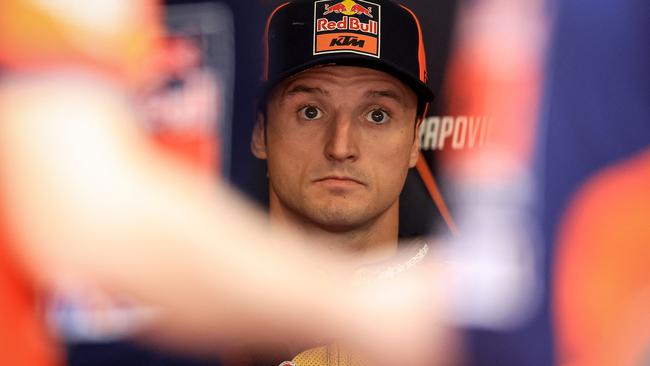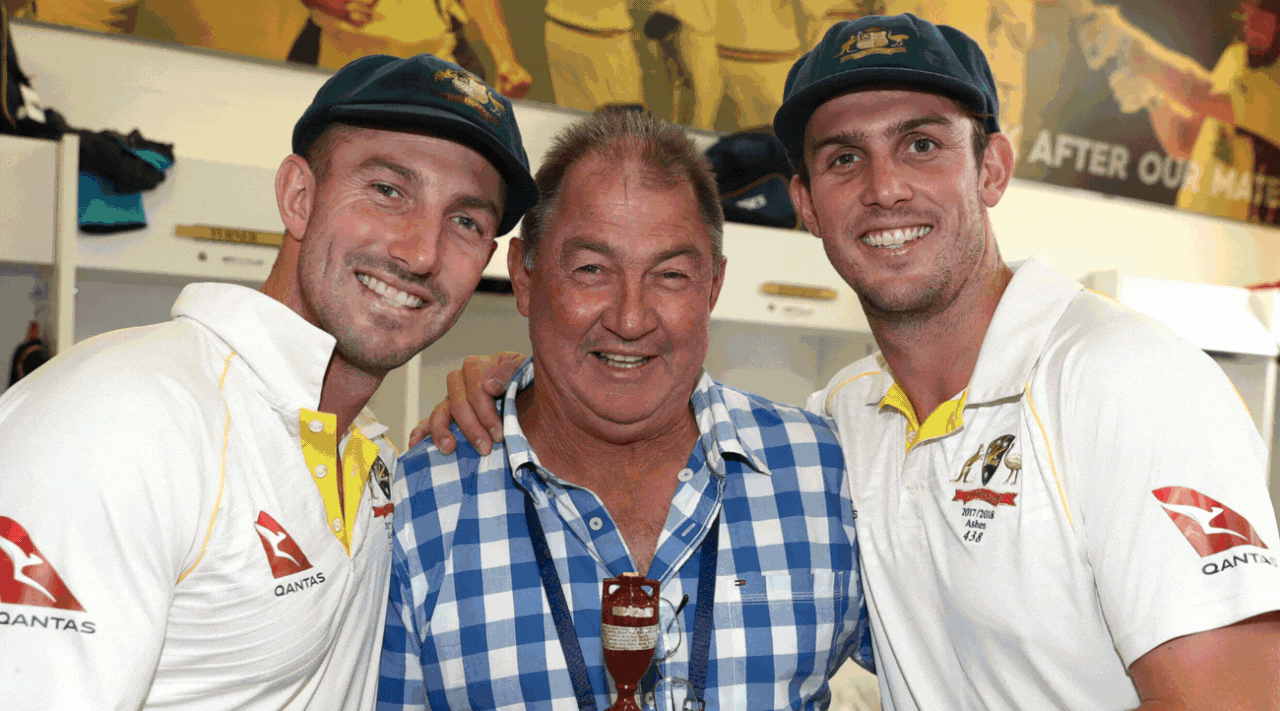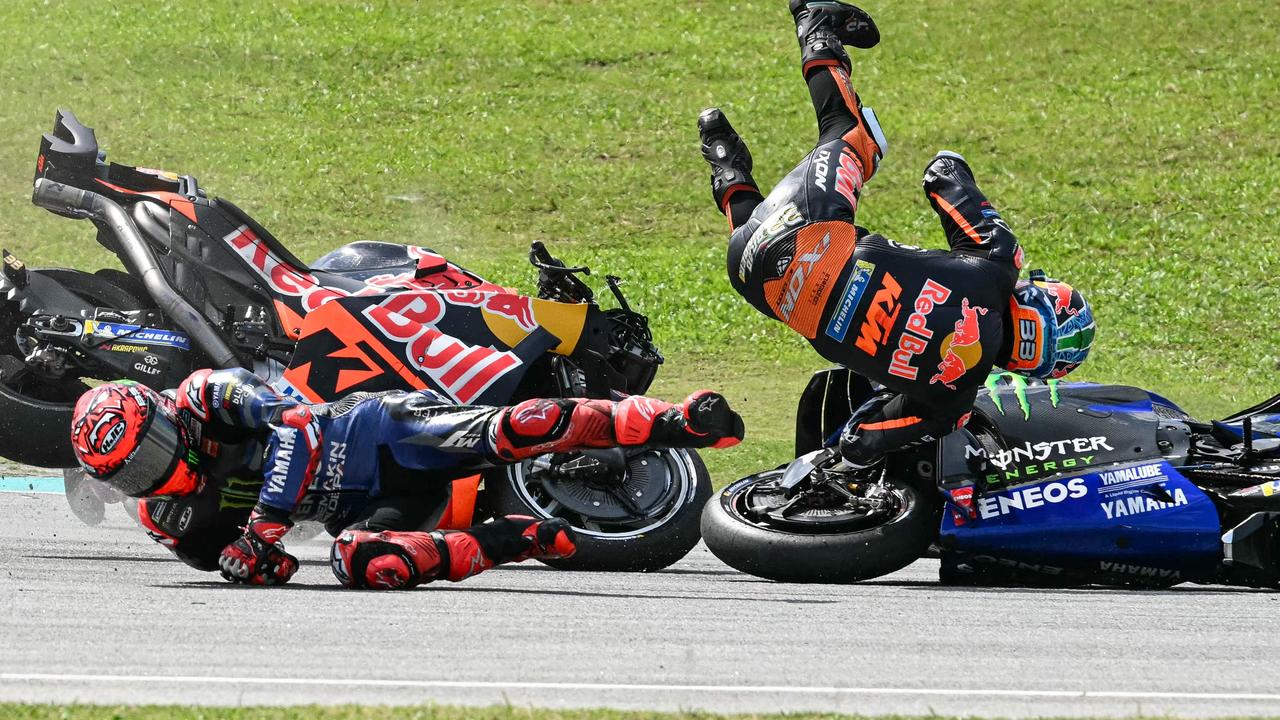A $28 billion sporting giant revolutionised F1. Will it do the same for MotoGP?
Liberty Media’s agreement to buy MotoGP’s commercial rights holder could shake up the premier two-wheel racing category — but will it be for the better?

Moto GP
Don't miss out on the headlines from Moto GP. Followed categories will be added to My News.
The global motorsport landscape is set to be shaken up, with F1 owner Liberty Media agreeing to buy MotoGP organiser Dorna Sports.
The purchase will bring the world’s premier four-wheel and two-wheel categories under the same roof for the first time in history in a deal valued at around $4.5 billion.
The size of the deal will require approval by competition authorities and foreign investment boards in at least four jurisdictions.
Every MotoGP qualifying, practice and race LIVE and ad-break free from lights out to the chequered flag. New to Kayo? Start Your Free Trial Today >
But most motorcycle racing fans won’t have the intricacies of multinational ownership on their minds.
They’ll be more concerned about what this could mean for the 75-year-old grand prix motorcycle racing championship.
Liberty Media, with a sports assets empire worth some $28 billion, has been understandably light on detailed plans so early in the process, but it’s so far given the impression of wanting to build on MotoGP’s existing infrastructure rather than tear it down and rebuild it.
It’s an understandable position given the sport’s tremendous on-track spectacle.
But like Formula 1 when Liberty first acquired it in 2017, there’s much work to do off the track.
Understanding how the Liberty era might unfold in MotoGP, it’s worth considering how the American media giant changed Formula 1.
F1 UNDER LIBERTY MEDIA
Anyone who thinks F1 isn’t in better shape in the Liberty Media era hasn’t been paying attention.
By any metric F1 is in better shape than it’s ever been.
Television viewership? Up.
Digital engagement? Massively up.
Race attendances? Almost always sold out.
And while it might sound counterintuitive after a season of record domination, the sport has never been healthier.
Three F1 teams collapsed in the five years prior to Liberty Media’s purchase — or four if you include USF1, which failed before making it to its first race.
The cost of competition had been allowed to balloon in the 2000s, and the financial crisis at the end of that decade put the sport and most teams in parlous financial positions.
You can draw a straight line from those dark days to the Williams family being forced to sell its historically successful team in 2020 and even to its ongoing struggles today.
Key changes made under Liberty’s stewardship reversed that dangerous trend.
The cost cap has ensured teams can’t spend their way to oblivion and guarantees them security to invest in themselves. Combined with equalisation measures that limit development, the field is slowly closing, even if Red Bull Racing remains clear at the front.
The regulation rewrite for 2022 also improved the quality of the racing, even if some of the beneficial effects have since worn off.
And while sprint racing remains controversial among some fans, it’s been a hit for TV audiences — so much so that MotoGP subsequently adapted the format at every round.
Off-track gains were a combination of low-hanging fruit and ambitious punts.
Just by developing a fit-for-purpose website and launching social media accounts — and allowing fans to share F1 content online — Liberty made the sport immediately visible to hundreds of millions of additional people.
Drive to Survive, commissioned in the early days of Liberty’s reign, has been so successful in drawing in new audiences that it’s become a byword for the sports docudrama genre.
Almost overnight F1 was made more appealing to new, younger audiences, to whom grand prix racing was made more accessible on both TV and in person.
This has all been possible because Liberty Media has been willing to invest in Formula 1 after years of management practices by CVC Capital Partners, which extracted value from the series rather than grow the pie.
Today the sport is massively profitable, with all 10 teams are in rude financial health.
The sale of a minority stake in Aston Martin last year reportedly valued the team at $1.85 billion. Even the declining Alpine team achieved a similar $1.36 billion valuation in 2023.
This scenario was unthinkable less than a decade ago, and Liberty Media can claim credit for much of it.
None of this should minimise Bernie Ecclestone’s enormous and important influence on the sport during his four decades at the helm.
F1 owes its existence as we understand it to Ecclestone’s vision, which turned essentially an amateur sport into a global racing behemoth.
But by the end of his tenure he’d run out of ideas to keep the sport relevant in a world of rapidly changing media consumption and sport engagement.
Now, after seven years of Liberty stewardship, Formula 1 has never been healthier.
BUT IT’S NOT ALL ROSY
Of course all the good Liberty has done can’t shield it from fair criticism of its management.
While MotoGP fans should be optimistic that the sport has massive potential for growth, they’ll fairly fear that the premier class could fall foul to some of F1’s vices.
Unsustainable calendar expansion
Formula 1 has developed a voracious appetite for calendar expansion in the Liberty era. This year’s season features a record 24 races, and there are constant rumours this could be upped again after 2026.
MotoGP already faces similar problems.
This year was set for a record 22 races before the cancellation of the Argentine Grand Prix.
But even with 21 grands prix — or 42 races including sprints — the premier class is butting up against the same issues as Formula 1.
The ballooning schedules are placing a massive burden on each sport’s rank and file as well as the drivers and riders.
Staff are lumbered with increasing time crammed into economy crisscrossing the time zones — a minimum of 266 hours over 42 weeks in Formula 1 this season — while even the star athletes are talking about the struggle of maintaining peak fitness for the full campaign.
In F1 this manifested in illnesses late in 2023. In MotoGP it’s seen in the skyrocketing injury rate.
Fans also take a hit. Whereas once a grand prix was appointment viewing owing to the scarcity of events, there are now so many races that the audience might no longer consider every round as essential programming to understand the story of the season.
Bigger isn’t always better. Sometimes less really is more.
But more races mean a bigger bottom line, and the dollar always wins.
Americanisation
F1’s traditional fan base has long criticised the sport’s focus on the United States under the reign of US company Liberty.
It wasn’t that long ago that the United States hosted no grands prix, and at times even the 2012 appearance of the Circuit of the Americas seemed temporary in the face of F1’s massive financial demands.
Liberty, however, has fostered two additional US races with statement events in Miami and Las Vegas that have benefited the sport overall Stateside.
Some have derided the glut of American races on the calendar as the Americanisation of the Formula 1.
However, those critics will ignore that by population North America has fewer races per million people than either Europe or the Middle East. It also fundamentally misunderstands the distance between the three races in the US and the appetite for sport in that country.
But it’s true to say is that F1 has turned away from Asia and towards the Americas during Liberty’s reign.
Whereas Ecclestone — admittedly haphazardly and unsustainably — attempted to crack the east, Liberty has shown comparatively little interest in the world’s most inhabited continent. Rumours of a potential South Korean Grand Prix have long gone quiet, and whispers of a return to Malaysia have never had much substance.
There’s also markedly reduced interest in China, where once a second and perhaps even third race seemed virtually certain, though this would have as much to do with geopolitical factors as anything else.
This is both an opportunity and a risk for MotoGP.
The appeal of pushing in the United States is clear: it’s a cashed-up and sport-mad consumer market with access to more than a billion people in the same time zone.
But MotoGP has a deep connection with the less lucrative Asian market, not least because the continent is a massive motorcycle market.
The sport races six times in Asia, including destinations in Japan, India, Thailand, Malaysia, Indonesia and Australia. They’re hugely popular among riders and fans.
The sport races only once in all the Americas. With the calendar already at bursting point with a nominal 22 grands prix, there isn’t the same scope to add races in the US and nearby without taking some away from elsewhere, setting up a potentially major friction point for the sport.
Heritage
That in turn brings Liberty’s relationship with F1’s heritage into the spotlight.
Some have accused F1’s owners of undervaluing the sport’s history in pursuit of growth. Change is necessary to attract new and changing audience, and not every tradition is worth keeping.
But is it true?
On Liberty’s watch F1 has lost both the German and the French grands prix, while the historic Belgian Grand Prix is widely rumoured to be in its final years of holding a permanent place on the calendar, with a rotation deal with the Dutch Grand Prix said to be on the cards.
But F1 has also had its presence in key heartlands bolstered, including with the reinstatement of the Dutch and Emilia-Romagna grands prix as well as extensions for at-risk races in Monaco and Brazil.
Several historic venues — including in Australia, the UK, Hungary, Canada and Austria — have had their contracts extended into the next decade.
How might that translate into MotoGP?
If expansion into new territories is the aim, it’s hard to see how the Iberian Peninsula can continue hosting five grands prix per season. The sport briefly considered rotating between them last year but brought all five back for 2024.
It’s an obvious starting place, at least with Spain’s four rounds. A similar fate could be considered for Italy’s two races, possibly opening a new source of pain.
But acting as a potential bulwark to any overly ambitious changes is that CEO Carmelo Ezpeleta and the current Dorna board will continue in place in Madrid with a small shareholding in the sport — in stark contrast to Bernie Ecclestone’s dismissal after the 2017 takeover.
WHERE MOTOGP STARTS AHEAD
All that said, it’s hard not to see massive upside in Liberty’s acquisition, particularly given it intends to pick up a majority stake in Dorna from passive investment vehicles.
That’s especially true given MotoGP has already shown itself to be embracing of change.
The sport has already been through the process of rewriting the rules to close the field in the MotoGP era. Now podium places and even victories are open to more teams than in any other international top-tier motorsport category.
That was achieved through Dorna having a more significant influence in the regulation of the sport than Liberty has in F1, where the FIA plays a greater — and more obstructive, at least lately — role than the equivalent FIM does in the bike world.
And it’s important to note that in some areas MotoGP has historically led F1. The sport’s strong visual brand, online presence and world feed offering have long been first in class.
In other areas MotoGP has attempted to adapt F1 innovations, including with sprint races and even things as simple as theme music and opening titles, all of which contribute to the spectacle.
But where Liberty can boost the sport most obviously is in unlocking new fans by making the sport more accessible.
In F1 it achieved that by putting drivers at the centre of the spectacle.
That used to be the case in MotoGP too. In the so-called Alien era the premier class was dominated by the combustible personalities of Valentino Rossi, Jorge Lorenzo, Casey Stoner, Dani Pedrosa and, later, Marc Márquez.
But their ubiquity left little oxygen for the next generation. When they one by one bowed out of the sport — or, in Márquez’s case, lost years to injury — MotoGP lost its selling point.
The diehards remain — they always do — but a generation of potential fans never found the sport.
It’s a similar conundrum to that faced by tennis in the aftermath of domination by the so-called ‘big four’.
Formula 1 has excelled at turning all its drivers into big personalities. Drive to Survive is its biggest weapon, but it’s a broader strategy than just that.
It’s the key to securing MotoGP’s future, and Liberty has a strong track record in delivery.
IT’S NOT A DONE DEAL YET
Liberty Media must first secure approval from competition authorities in the UK and Europe — and in Brazil and Australia — before completing its purchase at the end of the year.
There’s precedent for it to be knocked back.
In 2006 CVC Capital Partners was required to divest its share in MotoGP before it could buy Formula 1, with the two sports being considered each other’s biggest motorsport competitor by the European competition regulator.
MotoGP and F1 are more closely aligned than they were then, sharing five circuits and several broadcasters.
But it’s also true that the sport and broadcast landscapes have shifted significantly in the last 18 years.
Dorna was also allowed to acquire the commercial rights of the World Superbike Championship in 2012.
Liberty is making assurances that Dorna won’t be absorbed into F1. The two business will remain separate and free to compete.
Instead the American media company believes lessons learnt rebuilding F1 can be applied to MotoGP, where the ground would appear more fertile than it did when it first stepped into the motorsport landscape in 2017.
The quality of the MotoGP show has long deserved more attention from the casual motorsport audience. Liberty’s F1 experience could be what makes the difference.
Originally published as A $28 billion sporting giant revolutionised F1. Will it do the same for MotoGP?


